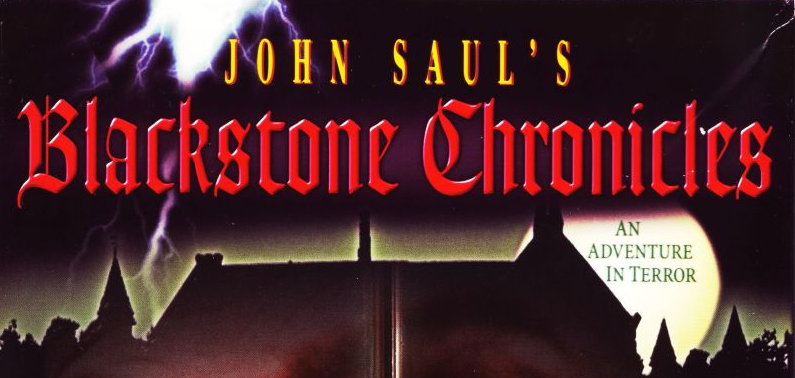
Ever since the eighties, and continuining in the nineties, it was normal for many novelists to be directly involved in the process of developing a story for videogames. And not just simply hired to mentor the then-real writers, but to help along the process of converting their original books in gaming form. Indeed, this is something that has gradually stopped happening, or maybe it is not such a big marketing feature anymore, but there are still several examples of graphical adventures from the two decades that had the original writers on board. Harlan Ellison got directly involved with the development of I have no mouth and I must scream, Arthur C. Clarke did the same with Sierra’s sci-fi adventure Rama and so did John Saul, writer of Blackstone Chronicles.
As stated in the manual’s introduction, he has always been a fan of adventure games, “since the days of textual adventures”. Even while writing the series as a fully episodic chronicle, basically inspired by what Stephen King did with The Green Mile, he felt that the material was perfectly suited for the gaming world. So, with the help of Bob Bates of Legend Entertainment, who gets co-writing and designer credits, the graphical adventure game based on the dreary world of the people of Blackstone (New Hampshire) is finally released to the public, just in time for the Halloween season of 1998.
A game of unspeakable sadness and pain…
The player steps in the shoes of Oliver Metcalf, the son of the last superintendent of a psychiatric hospital that has just reopened after many years. The former hospital has now been transformed into a sort of museum of psychiatric history. Oliver will soon find out that it’s actually more of a “museum of the history of mental patients treatment”, as he soon discovers to be trapped inside, as the game begins. Along with escaping with our life, the task will be to save Oliver’s child who has been kidnapped by none other than the aforementioned deceased father, back from the dead with a sinister plot in his ghostly mind.
Chronicles employs a classic first person perspective, a rather obvious choice since the players will spend all of their time walking around the psychiatric hospital. But Oliver will not be alone, since there is the almost costant company of the main antagonist, who will advance the plot by speaking telepathically with his son. Indeed, there are no cutscenes, except for the intro, and all of the narrative is carried out through conversations in first person, with the various paintings in the museum.

As a fan of horror in general I do not like to overhype things, so I can be completely honest in stating that John Saul’s Blackstone Chronicles is one of the most effective horror adventure games I’ve played. Even though gameplaywise there’s little that would be worth mentioning as special, this is one of the few adventures that manages to work on two different levels. It is both a pure horror game, with the usual foreboding atmosphere, traps and sudden dangers to avoid, and a rather terrifying stroll down history lane, uncovering how horribly people with mental conditions were treated, even as late as the 1940s.
The patients relate their stories through diaries or letters and hearing their first-hand accounts is pretty depressing and disquieting. Those terrible events will stay with the player long after they have finished the game, thus fully earning it the subtitle: “an adventure in terror”. Indeed. The plot itself, conceived as a sequel and sort of big conclusion to the events narrated in the Blackstone Chronicles novels, as a whole, is alright. There’s no need to know in detail any of the books in order to enjoy the game, which is a wise design choice. Interestingly enough, I would argue that the atmosphere of the adventure manages to surpass that of the books, which are average horror novels from the 90s, being much more effective in its realistic accounts of the sufferings of patients.

Further good news, most puzzles are consistent, either inventory-based or pure logical conundrums; nothing is terribly hard or obtuse and they won’t get in the way of Oliver’s walk down the sanitarium’s halls. There would be one exception though: the timed events. This is where Oliver has to do bring an object to a specific room or just race against the clock: either he wins or he dies. They can get a little repetitive when one has no clear no idea about what to do; those would have been best left on the cutting floor. Then again, as one might have guessed, Blackstone Chronicles’ nature is not that of an exciting horror action-adventure. Then again, when I introduced it as a “first-person adventure game of the nineties”, I would think nobody was expecting anything to be very exciting in that regard.
As mentioned above, most of the narrative consists of texts and voiceovers, there are no sequences that show the tortures and the ordeals the poor patients went through. Luckily, that was the best choice Legend could have taken. Voice actors are generally pretty competent, with a few notable exceptions, like our main protagonist. The musical score, while not terribly memorable, is also, for the most part, pretty good, and does its job as a “serious eighties horror” soundtrack. I would also like to mention the art they used for the box, while I am sure they were not aiming at a cheap horror VHS from 1985 look, the vibe seems to be exactly that.
I’m not sure that the Blackstone series was famous enough to warrant any kind of faithfulness to the books, but, if any fans of the books are wondering, the game stays pretty close to the original tone of the novels. It also shares some of the original characters, with Oliver Metcalf being featured as the main protagonist of the series, while his father is probably a late addition. With the episodic format going pretty much out of stile by the end of the 90s, The Blackstone series ended up being quickly forgotten, it has been laying dormant ever since the conclusion to the original series in 1997. That, plus a lukewarm critical reception, are some of the elements that prevented the game from becoming much more popular or even a cult classic in later years.
Weirdly enough, one would expect the Blackstone Chronicles game to very much share the same fate of Harlan Ellison’s adventure game, but that was not to be. Then again, this is neither so weird nor so shocking that can be easily recommended, either the player has the patience to sit down and want to learn about what was going on in mental health treatments in 20s and 30s, or there is little else of interest for non-fans of the books. So, one likes their horror games to be real slow burners with lots of reading and disqueting information on how actually horrible the human race is and always has been, well then, Blackstone Chronicles will definitely do the trick.
Mental health seemed to be a rather beloved subject for other horror adventure games back in the 90s. The same year saw the release of another adventure game set in a mental asylum, Sanitarium. Weirdly enough, while I’ve always been the most strenuous defender of this game, buying it the day it came out, it is safe to say that it did not really bring anything new to the table in regards to design and plot. Despite several interesting ideas, as a whole it never rises above its good intentions and premise. Some of its sequences irritated me so much that I’ve played it ten times and only finished it maybe twice. And yet, it’s much more popular and easier to find today than Blackstone Chronicles, it was even ported on Android.

But the true modern heir to Blackstone Chronicles is actually a little indie game called The Town of Light, developed in 2017 by LKA, an Italian studio. The game brings the player back to the days when the Psychiatric Institute of Volterra (near Pisa, in Tuscany) was still operational. It follows the story of young Renée and allows the player to learn about the various treatments and abuses the patients would receive.
Though not all encompassing and detailed like Blackstone Chronicles, it works in a similar way juxtaposing personal drama with the treatment of mental illnesses. Besides, being developed with Unity, ToL sports modern 3D graphics and a much more immersive experience than just reading letters, especially ’cause the old Institute was recreated in 3D with wonderful care and attention. Obviously, Town of Light is more akin to a “walking simulator” than an adventure game, there are no puzzles to speak of and all the player needs to do to advance is find pages or objects. But still, while the two titles employ different gameplay styles, in the end, they seem to achieve similar narrative results.





